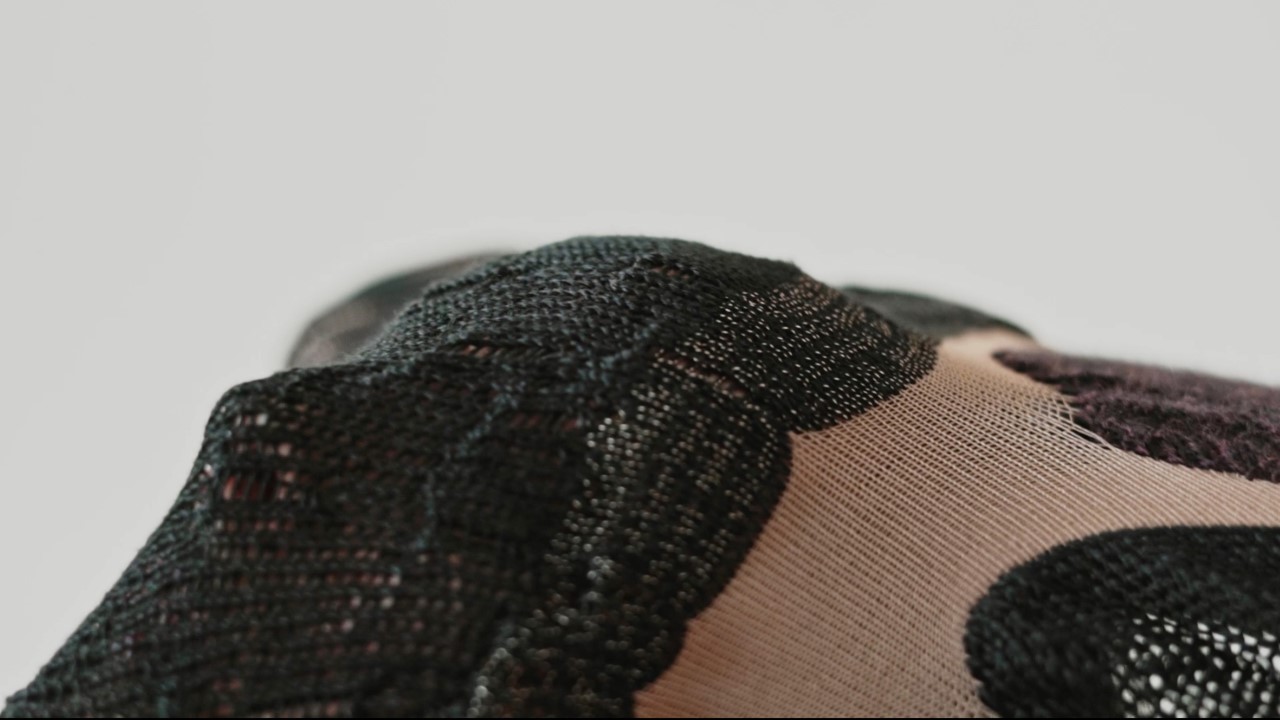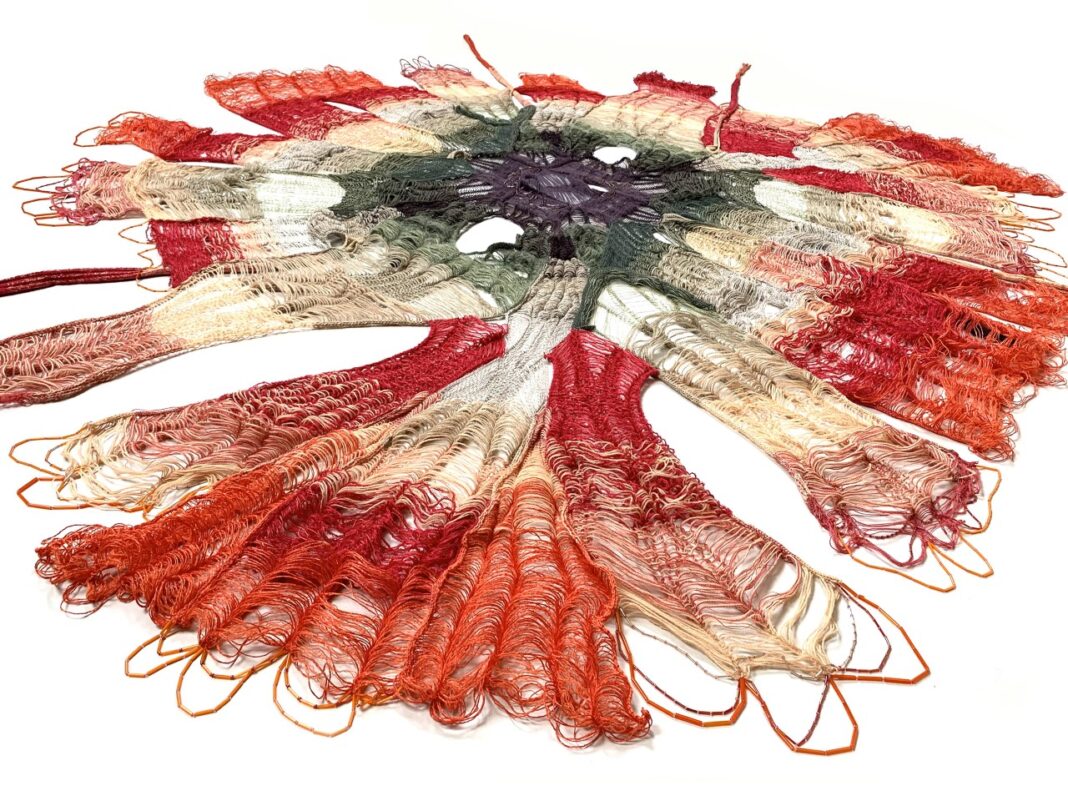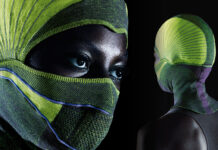Interdisciplinary design graduate Nastia Osadchenko’s collection ‘The New Physical’ explores the connection between knitted textiles and contemporary dance.
The roots of her inspiration are held within contemporary dance and Zeitgeist research, formed around cultural analysis. When the pandemic hit, tactility between dancers on stage was lost. The New Physical explores this symptom of the pandemic and offers knitted solutions.

Finding herself feeling out of place at home in Moscow, she made the move to Europe. This summer, Nastia graduated with a degree in BA Fashion and Textile Technologies at the Amsterdam Fashion Institute, and she has continued to live there since.
“My four years in Amsterdam have been diverse and have formed my unique perspective of the world. By seeking to capture the creativity in the world around me I am constantly re shaping this perspective, as well as my vision of the future.”
“My love of dance is also important to me. I practice contemporary dance, and the art of dance is something I can’t seem to live without. My thoughts, ideas and creative projects always seem to circle back to inspiration from body movement.”
As a mixed media maker, Nastia discovered machine knitting whilst studying, and it was this particular making method which became the driving force for her project.
The New Physical
Nastia describes her The New Physical as her most “explorative and challenging” project to date.
The project culminates in fabrics, a dance film, and a documentary. Nastia’s dance film presents a future scenario proposal which merges contemporary dance with knitted textiles. The video is a visual culmination of the fabrics she created. Four machine knitted textile pieces feature in the film, representative of her twenty-six-piece strong fabric collection. For the dancers in her video, Nastia made four costumes which adorn their bodies whilst they perform improvisation driven dance routines with a choreographic storyline. Nastia created an additional short documentary film which details her creative process.
Contemporary dance meets knitted textiles
It was the circumstances resulting from the global pandemic which first inspired Nastia’s explorations into how machine knitted textiles could ‘meet’ contemporary dance. Explaining how her passions combined, Nastia shared: “The New Physical explores how our pandemic reality re-defined and restricted the notion of physical contact. In the context of contemporary dance, this resulted in a lack of partnerwork* and the loss of a shared physical environment on stage. The idea for my project was to restore the lost physicality between dancers through alternative senses and resources.”
“Machine-knitted textile creations guide the dance movement, reviving interconnection between the performers. In many ways, knitting is like choreography for me. Knitted fabrics create many possibilities: knits can be flexible, stretchy or fluid. On the contrary they can also be stiff, restricting and tense. These qualities reflect dance movement, making it a natural choice to combine the two ‘disciplines’.”

Though her knitted fabrics do drape on the body and exhibit features of garments Nastia explained: “It would not be accurate to call my pieces ‘knitwear’ because the pieces are not meant to fit the body. I see these textiles as pieces of art. They are abstract shapes with playful surfaces that are intended as choreographic tools. Performers can utilise the ‘handles’ and ‘openings’ which I have placed within the fabrics to inspire, enhance and restrict movement. * ‘Partnerwork’ in this context refers to a term from dance vocabulary, therefore is written as one word.”
How do you see this connection evolving post pandemic?
“Within the dance industry, the issue of disconnectedness during the pandemic became something that professionals had no choice but to adapt to. The adaptation process became a path towards innovation and experimentation.”
“The important thing for me is that my project illustrates that the industry is in need of fresh vision, collaborative work and interdisciplinary narratives. As well as this, the project also presents a fresh take on how machine knitting can become embedded within an unconventional artistic discipline and thrive. This ‘revelation’ holds a lot of potential post pandemic.”
Do you feel that the pandemic drove your interest in this topic? Or has dance and movement of the body with knit always been important to you as an area of exploration?
“It is hard for me to separate the subjects now – knit, dance, movement and the pandemic challenges. The elements all came together naturally and perhaps this is because I am deeply interested in each topic individually as well as collectively. The pandemic was a current global issue which felt important to explore and impossible to ignore. Knit is the technique I specialise in within my textile practice. Dance is my other passion in life. When I break it down in this way, all these areas were instinctive choices for the project concept, though it was the first time I had approached them together.”
Fabrication Details
Nastia’s textiles have specific narratives entwined within them. Within the dance performance, three chapters form the story, and the textile pieces form visual illustrations. Through visual cues and expressive tactility, the fabrics tell a story of their own whilst facilitating the expressive body movements of the dancers in their dance narrative.

Chapter one details the dark state of mind experienced through the restrictions of the first phase of the pandemic. Nastia’s textiles emulate this mood through moody colour choices and thick, chunky yarns combined with elastics to restrict flexibility throughout the knitted fabric. The dancer is ‘captured’ by the fabric.


Chapter two introduces the second dancer and represents a search for freedom. A playfulness develops between dancer and fabric, and two knitted pieces – one for each dancer- are introduced. The two knits differ aesthetically. An uplifting, playful mood is created with contrasts between light and dark, thin and chunky, dense and transparent.

Chapter three embodies the revival and restoration phase of the pandemic through mutual exploration of the textiles between the dancers. The large, knitted fabric in this chapter is expressive in technique and colour, and as a ‘shared’ piece it facilitates interconnection between the dancers by reintroducing partnerwork. A gradient of colours expands from purple to raspberry-pink and orange. The fluidity of this fabric directly contrasts the restrictions from chapter one, with knitted floats and openings through which the dancers can emerge and escape.
What yarns, fibres and materials have you used within your fabrics?
Aesthetic, narrative and structural considerations informed Nastia’s material choices. “All textile decisions were made based on the performance of the knits: stretch, density, fragility, loose floats, holes and openings. How the knit could perform consequently influenced the dance movements and guided the choreography.”
Where feelings of restriction were required, thicker yarns blended from linen, wool, cotton and metals were used. “The most exciting surfaces were formed with linen, as it holds shape and doesn’t allow much movement. A special element in chapter one was the elastic yarn. Usually, the purpose of elastic is to enhance stretch and recovery, but I subverted this. knitted with the elastic in a way that created tension and resistance, creating a visual effect of restriction.”
When building the playful visual narrative of her second chapter, Nastia used contrasting yarns and fibres. Chunky sections were knitted with wool, linen and mohair to build depth, whilst lighter weight sections were knitted with silk, viscose and cotton to communicate fragility through translucency.
Chapter three explored more stable yarns, informed by the need to perform with strength. Nastia’s knitting technique using floats needed to be structurally sound and survive the impact of being integrated within in dance movements.

What knitting techniques did you use, and how did the fabric development process work alongside dance?
“Throughout the development phases the knitting went hand in hand with the choreographic process. I explored movement and improvisation possibilities with dancers, as well as their thoughts and feelings on my concept. Meanwhile I was reflecting on this as I developed my fabrics on the knitting machine. Once my elaborately crafted knits started influencing certain movements, the fabrics started to direct and guide the dancers. It then became a circular process.”
“My knitting developments guided the dancers, while at the same time, the dancers’ experience with these knits guided my choice of techniques, shapes and scale. As my fabrics developed, the dancers had to learn to interact through materials as a new form of tactile engagement, rather than traditional partnerwork.”
What was the biggest challenge during the process?
“The challenge was in convincing my assessors, textile advisors and myself that my combination of ideas could work. The unusually large knits, the dance performance, the interconnection of knits and dancers and the overall fact that it doesn’t relate to fashion or clothing meant this was a challenging project to present. I am glad I persevered and I am pleased with how it ultimately turned out.”

What are your ambitions for the future?
“I am still deeply invested in this line of enquiry. My goal now is to expand into larger scales, perhaps exploring stage and set design. Knitted objects and dancer interaction could be explored too – there are many possibilities. I would also like to collaborate with a choreographer and learn how dance and textiles can merge even further.”
“The New Physical has shown me that it is possible to merge even the most unexpected disciplines and combine varied areas of my interests. This has opened my mind to many possibilities. It now feels impossible to narrow down what I might do in the future and this is exciting for me.”
Nastia’s work is a physical and technical exploration of how knitted textiles can impact other creative disciplines. As technology within the knitting industry develops, the potential of this fabrication method has never been so exciting. With minds such as Nastia’s graduating into the ‘design world’, the future certainly holds some intriguing possibilities. For Nastia, this project is just the beginning.

Subscribe To Our Newsletter
Join our mailing list to receive the latest news and updates from our team.






